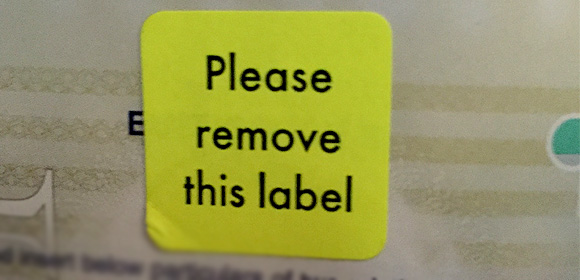
This label is on the ’emergency contacts’ page of my new passport.
Actually, it’s very clever.
It’s ‘nudge theory’ in action.
How to change our own and others’ habits is a big theme in leadership.
‘Changing behaviour’ is the goal of any leadership development work.
And of all ‘change programmes’.
But, most work to change behaviour or win hearts and minds or whatever, doesn’t.
Because most change work is too apparently intent on communicating “Look, I’m doing change work” or “Look, I’m developing leaders” rather than actually triggering a shift in behaviour.
Most change work is more concerned with raising awareness of its own existence, of its own process – with being seen to be doing something – and is then surprised at its lack of actual output.
And then has to make up metrics – all in good faith, I’m not suggesting conscious deception – that appear to show the desired change happened.
But don’t really.
As Allan Leighton once said of communicating change (not his actual words, I’m paraphrasing):
“Saying ‘We spent x amount of money on making and distributing a video to champion the change. We made everyone sit in town hall meetings and watch it. It was watched X,000 times by X,000 people…”
… may give you an A for effort. And a lot of input activity to report upwards: metrics or measures.
But it gives you no evidence that you have communicated properly or achieved any change at all.
Virtue signalling
Most change efforts are what is increasingly called virtue signalling – “Look at what I’m doing to further the cause.”
All you do with most change programmes is pass on the latest language or slogan. People, who aren’t stupid, pick it up and start using the new language, to virtue signal back to the organization that they have got the programme and are with it.
But, what I love about ‘nudge’ ways of changing how people behave is it doesn’t care if it looks stupid.
It isn’t trying to impress anyone.
The clue that the label, above, isn’t stupid, is the black on yellow. That’s what attracts the eye in marketing or advertising, psychologists tell us. So, someone put thought into that stupid-looking label.
Think about it for a second or two and there’s only one reason it can be there;
too many people don’t fill in this page with next of kin details.
Remove the label and you see the word ‘Emergency’.
You are reading the top of the page and you have already started doing something with that page – interacting by removing the label. You are engaged.
They’ve got your attention and made you do something. You are ‘in’ the page. And therefore more likely to pick up a pen and fill in the details.
They’ve changed how we behave. Without worrying about looking stupid.
No, I haven’t filled in the next of kin details: I wrote this instead. But, I will now. Honest.
More on using Nudge Theory to make change happen









Leave a Reply